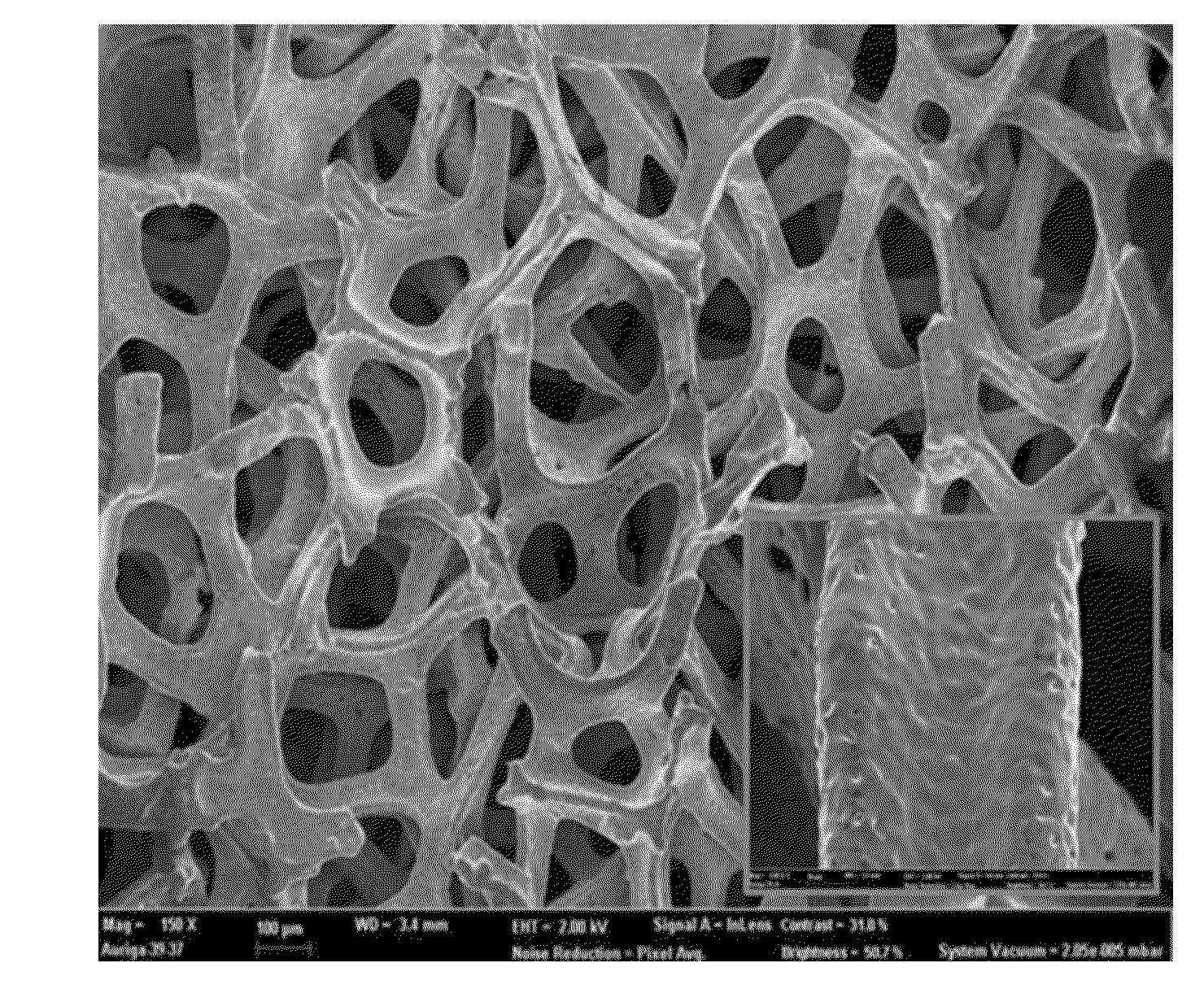Metal Foam for Electrode of Secondary Lithium Battery, Preparing Method Thereof, and Secondary Lithium Battery Including the Metal Foam
a lithium battery and metal foam technology, applied in the direction of electrochemical devices, electrical equipment, metallic material coating processes, etc., can solve the problems of powder materials degrading and falling off, unavoidable new electrode material innovation concept, and increasing contact resistance, so as to improve charge and discharge efficiency, reduce contact resistance, and improve the effect of cycling characteristics
- Summary
- Abstract
- Description
- Claims
- Application Information
AI Technical Summary
Benefits of technology
Problems solved by technology
Method used
Image
Examples
embodiment 1
[0066]Approximately 0.03 milliliters of 37 percent (weight / weight) HCl is blended with 0.47 milliliters of EtOH to prepare a mixture of the solvent, and 0.338 grams of SnCl2.2H2O, which is used as a precursor, is dissolved in the mixture to form a precursor solution (3 molar). After aging the precursor solution for 24 hours, 0.03 milliliters of deionized water is then added to the solution and the transparent gel solution is obtained by subsequent aging for 24 hours, in which hydrolysis and condensation polymerization take place. The disk-shaped copper foam (copper foam fabricated by electroless plating) with a diameter of 11 millimeters is immersed in the gel solution and then it is aged for 24 hours again. The copper foam is then taken out from the gel solution and is maintained in the vacuum oven for 24 hours at the temperature of 80 degrees Celsius in order to eliminate the solvent left in the inside and outside of the copper foam. The copper foam for a secondary lithium battery...
embodiment 2
[0068]The precursor solution (5 molar) is prepared by dissolving 0.563 grams of SnCl2.2H2O, which is a precursor to form a SnO2 coating layer in the later stage. The copper foam for use in a secondary lithium battery is subsequently fabricated after coating the surface and the inner pore wall with tin oxide by the same method as in the example 1, except that the gel solution precipitating the precursor is sonicated for 1 hour before immersing the copper foam in the gel solution.
[0069]FIG. 3C shows a SEM micrograph of the surface of the copper foam manufactured in this example. In the embodiment of the present invention, the pore wall of the copper foam is coated with tin oxide over a wide range by using a precursor solution that is more concentrated than that of example 1, which makes relatively bright areas more noticeable.
embodiment 3
[0070]Another copper foam for use in a secondary lithium battery having the surface and inner pore wall coated with tin oxide is fabricated by the same method as in the case of example 1, except that the precursor solution (10 molar) is produced in this case by dissolving 1.127 grams of SnCl2.2H2O to form a SnO2 coating layer.
[0071]FIG. 3D shows a SEM micrograph of the surface of the copper foam manufactured in this example. The pore walls of the copper foam are coated by tin oxide over a wider range, which makes relatively brighter areas more noticeable, since the precursor solution used in this example has higher concentration than those used in examples 1 and 2. Also, the surface area is increased more because the surface of the pore wall is formed more roughly due to the higher concentration of tin oxide coating.
PUM
| Property | Measurement | Unit |
|---|---|---|
| pore size | aaaaa | aaaaa |
| weight/weight | aaaaa | aaaaa |
| diameter | aaaaa | aaaaa |
Abstract
Description
Claims
Application Information
 Login to View More
Login to View More - R&D
- Intellectual Property
- Life Sciences
- Materials
- Tech Scout
- Unparalleled Data Quality
- Higher Quality Content
- 60% Fewer Hallucinations
Browse by: Latest US Patents, China's latest patents, Technical Efficacy Thesaurus, Application Domain, Technology Topic, Popular Technical Reports.
© 2025 PatSnap. All rights reserved.Legal|Privacy policy|Modern Slavery Act Transparency Statement|Sitemap|About US| Contact US: help@patsnap.com



